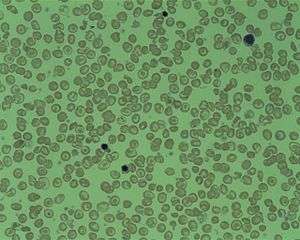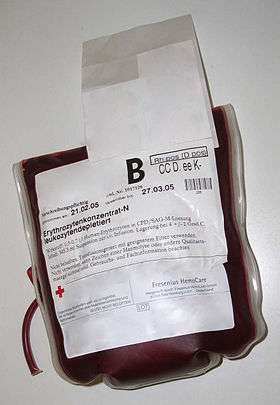Delta-beta thalassemia
Delta-beta thalassemia is a form of thalassemia, and is autosomal recessive in terms of heredity.[1] It is associated with hemoglobin subunit delta.[4]
| Delta-beta thalassemia | |
|---|---|
 | |
| Delta-beta thalassemia | |
| Specialty | Hematology |
| Causes | Produces only gamma-globin and forms HbF(deletes entire delta and beta gene sequence)[1] |
| Diagnostic method | CBC[2] |
| Treatment | Blood transfusions[3] |
Signs and symptoms
An individual with delta-beta thalassemia is usually asymptomatic, however microcytosis can occur where the red blood cells are abnormally small.[1][5]
Mechanism

In regards to genetics, delta-beta thalassemia is autosomal recessive,[1] which means both parents (two copies of the gene) must be present.[6] A carrier gets a normal gene to produce hemoglobin A, from one parent and the other parent supplies a gene which makes no hemoglobin A.[7] Delta-beta thalassemia is considered rare.[3]
In terms of the pathophysiology of delta-beta thalassemia, one finds delta and beta chains have deletion, therefore gamma genes are what is transcribed (made an RNA copy of[8]) on the impaired chromosome.[9]
When one inherits two delta0 mutations, no hemoglobin A2 (alpha2, delta2) can be formed. Hematologically, however, this is innocuous because only 2-3% of normal adult hemoglobin is hemoglobin A2. The individual will have normal hematological parameters (erythrocyte count, total hemoglobin, mean corpuscular volume). The delta-beta thalassemia demonstrates one mutation is at the +69 position.[10]
Relation to beta thalassemia
The importance of recognizing the existence of delta-beta thalassemia is seen best in cases where it may mask the diagnosis of beta thalassemia trait. In beta thalassemia, an increase in hemoglobin A2 results. However, the co-existence of a delta-beta thalassemia mutation will decrease the value of the hemoglobin A2 into the normal range, thereby obscuring the diagnosis of beta thalassemia trait[11]
Diagnosis
The diagnosis of delta-beta thalassemia is done via hypochromic microcytic red cell indices.[1] This test is a part of a CBC, and could be employed to diagnose the reason the individual might have anemia, in this case due to thalassemia.[2]
Treatment

In terms of treatment for delta-beta thalassemia one possible concern would be anemia, where, therefore, blood transfusions would be given to the affected individual (though blood transfusions might introduce complications, as well).[3]
Stem cell transplant is another option, but the donor and the individual who will receive the bone marrow transplant must be compatible, the risks involved should be evaluated, as well[3][12][13]
See also
References
- "Delta-beta-thalassemia". Orphanet. Orphanet. Retrieved 16 September 2016.
- "RBC indices: MedlinePlus Medical Encyclopedia". medlineplus.gov. Retrieved 17 September 2016.
- "Thalassaemia | Health | Patient". Patient. Retrieved 17 September 2016.
- "HBD - hemoglobin subunit delta". Orphanet. Orphanet. Retrieved 17 September 2016.
- Pal, G. K. & (2005). Textbook Of Practical Physiology - 2Nd Edn. Orient Blackswan. p. 53. ISBN 9788125029045. Retrieved 17 September 2016.
- "Autosomal recessive: MedlinePlus Medical Encyclopedia". medlineplus.gov. Retrieved 17 September 2016.
- "Delta beta thalassemia carrier" (PDF). Public Health England. Public Health England. Retrieved 17 September 2016.
- "Transcription and Translation - National Human Genome Research Institute (NHGRI)". www.genome.gov. NIH. Retrieved 17 September 2016.
- Proytcheva, edited by Maria (2010). Diagnostic pediatric hematopathology. Cambridge: Cambridge University Press. p. 61. ISBN 9780521881609. Retrieved 17 September 2016.CS1 maint: extra text: authors list (link)
- "OMIM Entry - * 142000 - HEMOGLOBIN--DELTA LOCUS; HBD". www.omim.org. Retrieved 17 September 2016.
- Galanello, Renzo; Origa, Raffaella (2010). "Beta-thalassemia". Orphanet Journal of Rare Diseases. 5 (1): 11. doi:10.1186/1750-1172-5-11. ISSN 1750-1172. PMC 2893117. PMID 20492708.
- Cao, Antonio; Galanello, Renzo (2010-02-01). "Beta-thalassemia". Genetics in Medicine. 12 (2): 61–76. doi:10.1097/GIM.0b013e3181cd68ed. ISSN 1098-3600. PMID 20098328.
- "Risks". nhs.uk. Retrieved 2018-04-28.
Further reading
- Verma, S; Bhargava, M; Mittal, SK; Gupta, R (1 January 2013). "Homozygous delta-beta Thalassemia in a Child: a Rare Cause of Elevated Fetal Hemoglobin". Iranian Journal of Pediatric Hematology and Oncology. 3 (1): 222–227. ISSN 2008-8892. PMC 3915439. PMID 24575268.
- Kumar, B. Vinodh; Choccalingam, Chidambharam; Samuel, Premila (1 March 2016). "Incidental Identification of Possible Delta-Beta Thalassemia Trait in a Family: A Rare Cause of Elevated Hb F." Journal of Clinical and Diagnostic Research. 10 (3): BD01–BD02. doi:10.7860/JCDR/2016/16352.7409. ISSN 2249-782X. PMC 4843246. PMID 27134860.
- "Public Health Information Network Vocabulary Access and Distribution System (PHIN VADS)". CDC. Centers for Disease Control. Retrieved 17 September 2016.